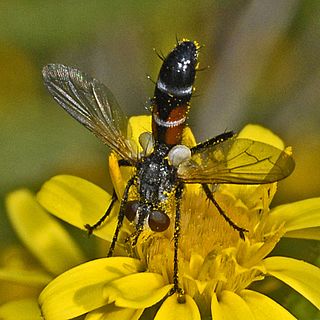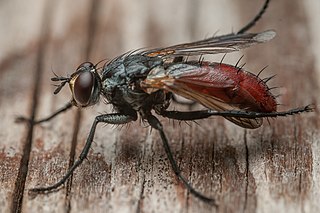Clytiomya is a genus of flies in the family Tachinidae.
Formosia is a genus of flies in the family Tachinidae.

Blondelia nigripes is a species of fly in the family Tachinidae.

Gonia picea is a Palaearctic species of fly in the family Tachinidae.
Gymnosoma costatum is a Palaearctic species of fly in the family Tachinidae.

Phasia obesa is a species of 'parasitic flies' belonging to the family Tachinidae subfamily Phasiinae.

Compsilura concinnata is a parasitoid native to Europe that was introduced to North America in 1906 to control the population of an exotic forest, univoltine, spongy moth named Lymantria dispar. It is an endoparasitoid of larvae and lives with its host for most of its life. Eventually the parasitoid ends up killing the host and occasionally eating it. It attacks over 200 host species, mainly insects from the Orders: Coleoptera, Lepidoptera and Hymenoptera. Since this parasite has the ability to attack many different types of hosts, the organism has spilled over from the intended forest systems into other areas, like agricultural fields, affecting cabbage pests including the cabbage looper (Trichoplusia); the cabbage worm ; and even other invasive species such as the brown-tail moth. However, it also attacks native, non-pest insects such as the Cecropia moth and American moon moth.
Zosteromeigenia mima is a species of fly in the family Tachinidae and the sole representative of the genus Zosteromeigenia. Like the vast majority of tachinid flies, Z. mima is expected to be a parasitoid of other arthropods, likely the larvae of Lepidoptera, however few or no host records exist.

Cylindromyia interrupta is a species of fly in the family Tachinidae.

Cylindromyia bicolor is a European species of fly in the family Tachinidae.
Clytiomya continua is a European species of fly in the family Tachinidae. Hosts for the parasitoid larvae include Coreus marginatus orientalis, Eurygaster testudinaria, Eurydema gebleri, Eurydema dominulus, Graphosoma rubrolineatum, Homalogonia confusa, and Dolycoris baccarum. Larval development takes six to eleven days.
Thelaira leucozona is a species of fly in the family Tachinidae first described by Georg Wolfgang Franz Panzer in 1806. It parasitizes moths such as Arctia caja by laying eggs in the larvae that eventually kill the host.
Periscepsia carbonaria is a species of fly in the family Tachinidae.
Sturmiopsis inferens is a species of fly in the family Tachinidae. It is native to Asia and is a parasitoid of various moth species whose larvae feed inside the stems of sugarcane, rice and other large grasses, including the Gurdaspur borer and the sugarcane shoot borer.
Euantha litturata is a species of bristle fly in the family Tachinidae.

Besseria anthophila is a species of bristle fly in the family Tachinidae.
Strongygaster globula is a species of bristle fly in the family Tachinidae.
Estheria pallicornis is a species of fly in the family Tachinidae.
Euamphibolia is a subgenus of flies in the family Tachinidae.
Periscepsia is a subgenus of flies in the family Tachinidae.






